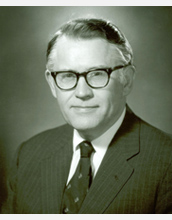
Image source: National Science Foundation
Dr. Guy Stever died recently at the age of 93. His was a most distinguished career. I can do no better to summarize it than to quote the description from his book, In War and Peace: My Life in Science and Technology:
Science came into Guy Stever s life as a pure and peaceful pursuit. It was only later, as he walked through the wreckage of wartime London that he began to see science as central to a desperate struggle to survive.I knew Dr. Stever through his service to the Board on Science and Technology for International Development (BOSTID) of the National Academies in the late 1970s and early 1980s. At the time he was the Foreign Secretary of the National Academy of Engineering, and I was the project manager of the USAID grant that funded BOSTID.
Past president of Carnegie Mellon University, former Chief Scientist of the U.S. Air Force, one-time Director of the National Science Foundation, professor at MIT for 20 years, member of the National Academies of Sciences and Engineering, and science advisor to two presidents Guy Stever was a central figure in twentieth century science consistently on the front lines, changing the fate of a nation.
In this thoughtful and candid memoir, Stever recounts an extraordinary life that reveals as much about the man as about the major scientific and technological events of his day. Born of humble origins and orphaned at an early age, Stever journeyed from a small town in New York to work alongside British comrades who were developing and refining the critical radar technology that was to turn the tide of the war against the Germans. As a technical intelligence officer, these harrowing wartime years took him from the beachheads of Normandy to the German slave-labor factories responsible for building the V-2 rockets.
Stever returned home committed to serving his country. He became intimately involved in America s nascent guided missile program and was to remain a key player in the anti-ballistic missile defense program that heralded the era of the Cold War. As the decades passed, Stever continued to exert lasting influence on countless scientific endeavors. He was instrumental in the formation of new institutions, from the creation of NASA in the post-Sputnik years to the merging of Carnegie Tech and the Mellon Institution, giving birth to Carnegie Mellon University. As Presidential Science Advisor to both Nixon and Ford, Stever shaped the very structure of contemporary presidential science advising. And he was to chair the oversight committee that redesigned the space shuttle boosters after the Challenger explosion.
Guy Stever s life offers remarkable insight into the twentieth century. Through his eyes, we relive the history of the past 50 years, witnesses to a tale of science and technology that is revealing in its scope and sweep.
I came to have great respect for his wisdom, his courtesy and his skill in the provision of scientific advise. Only later did I come to wonder at the willingness of this very important and very famous man to devote so much time and effort to helping develop science in poor nations and helping to make the fruits of science available to the poor in those nations. I was very fortunate to come to know the gentleman!
No comments:
Post a Comment